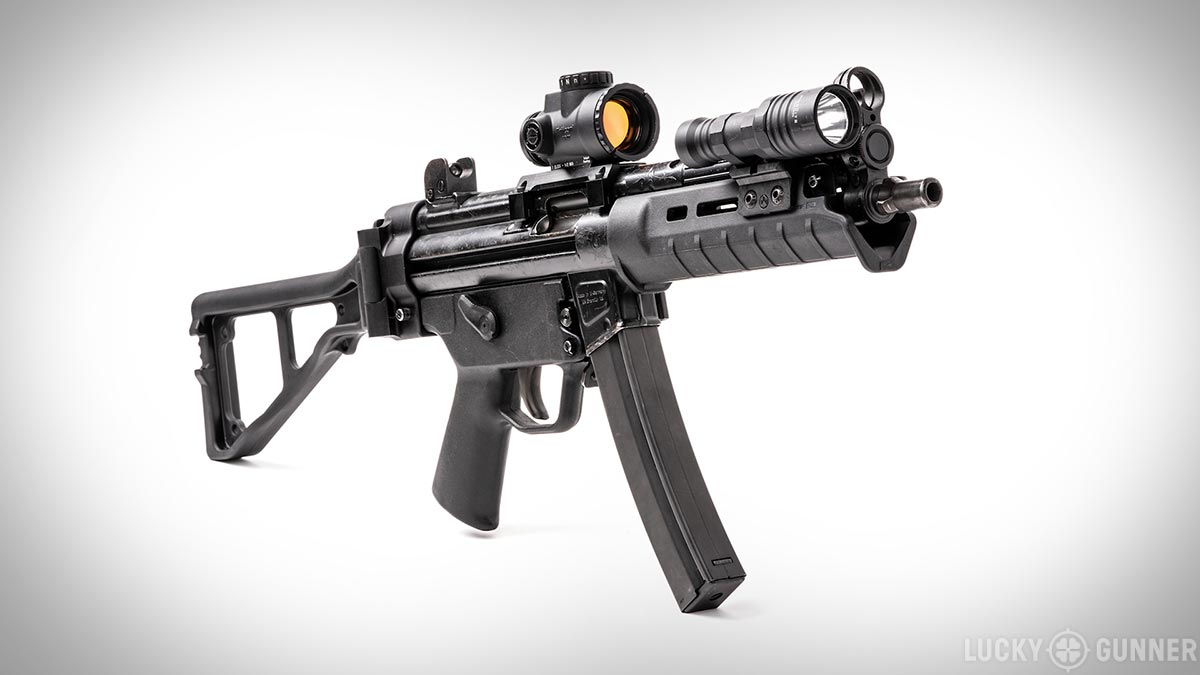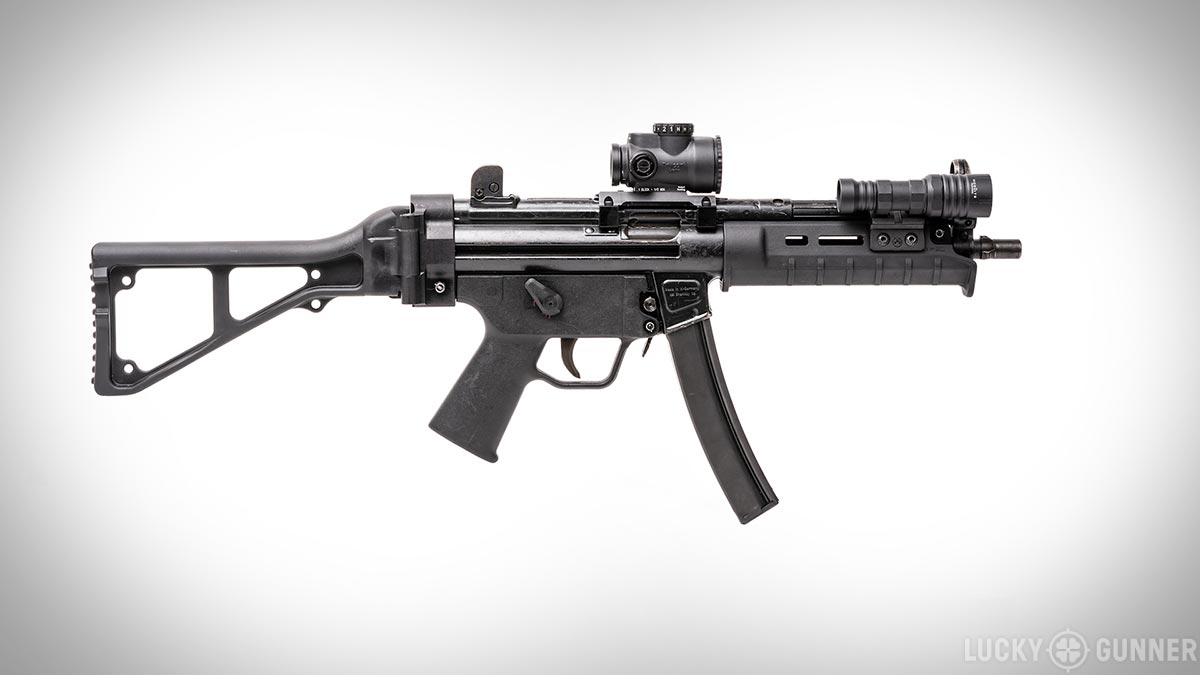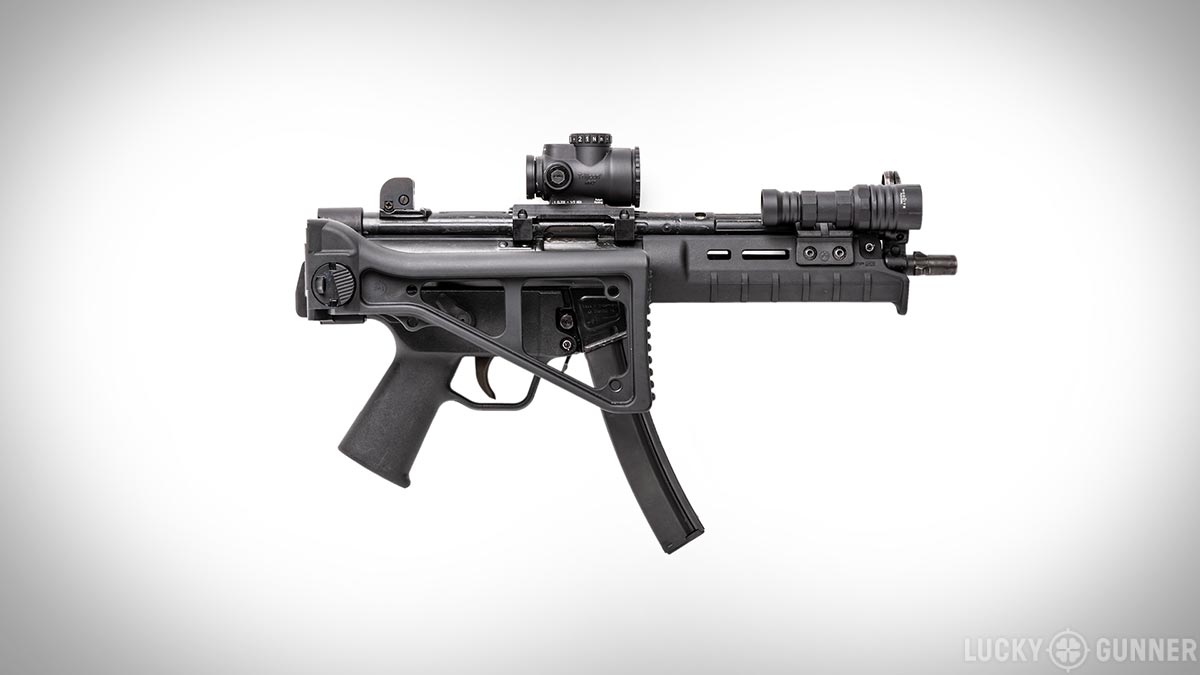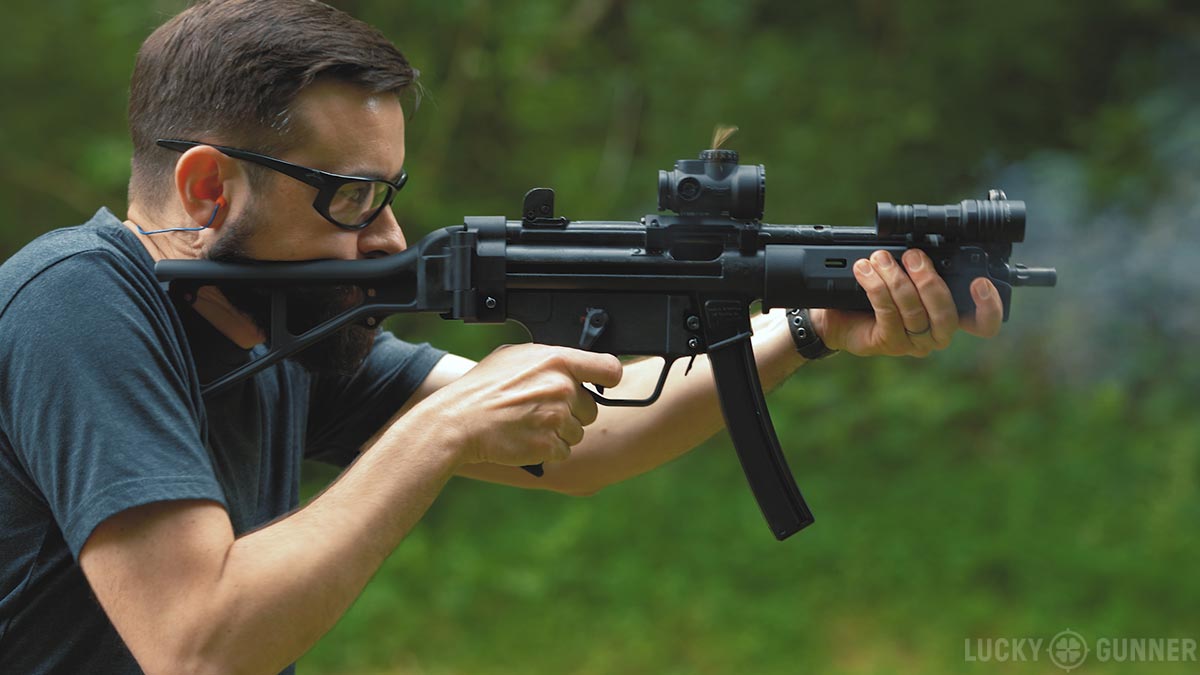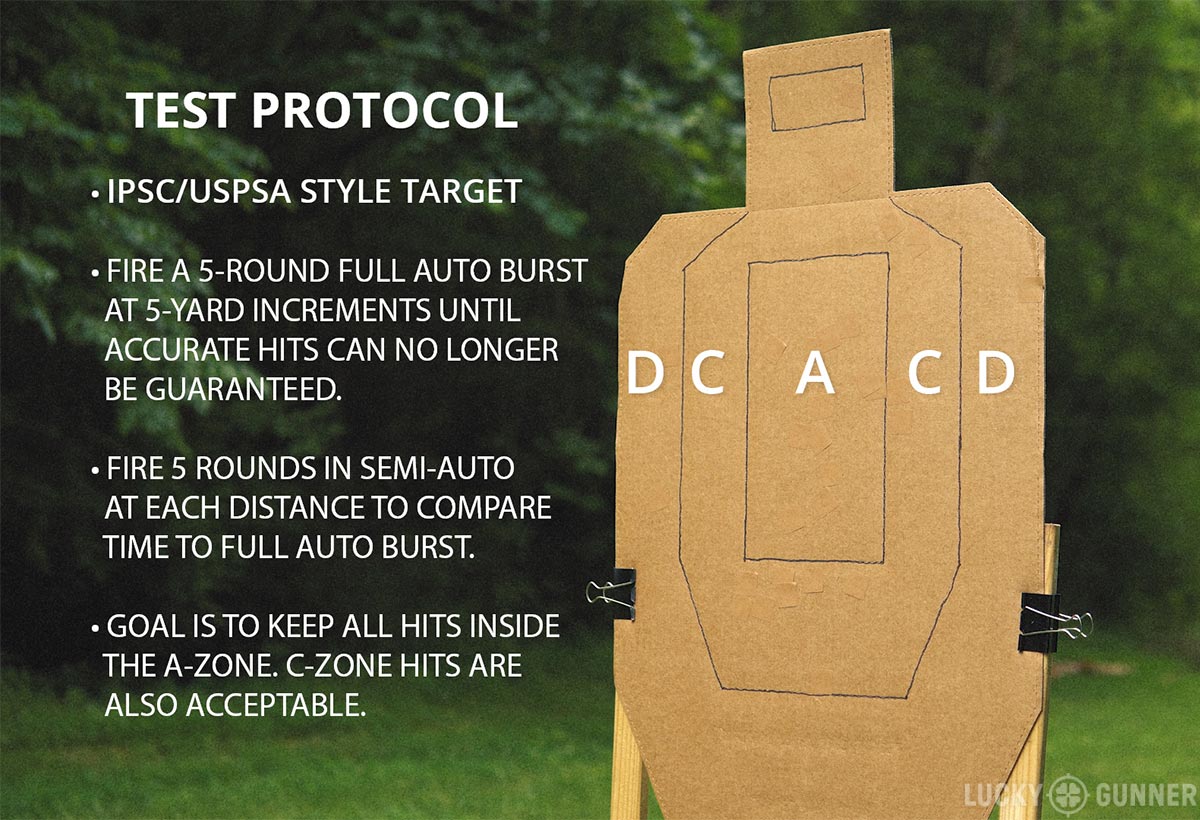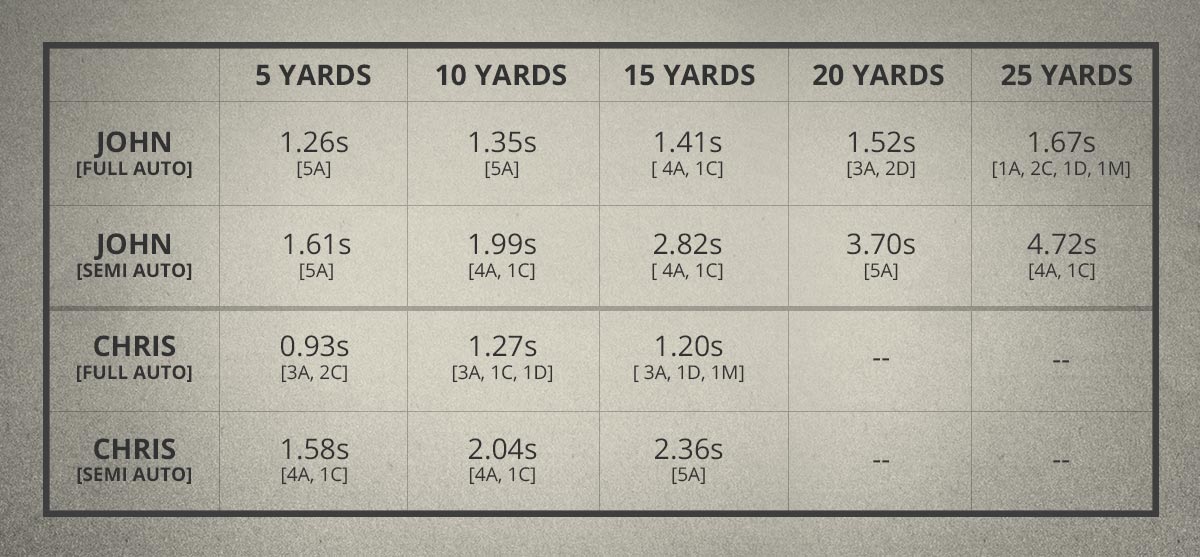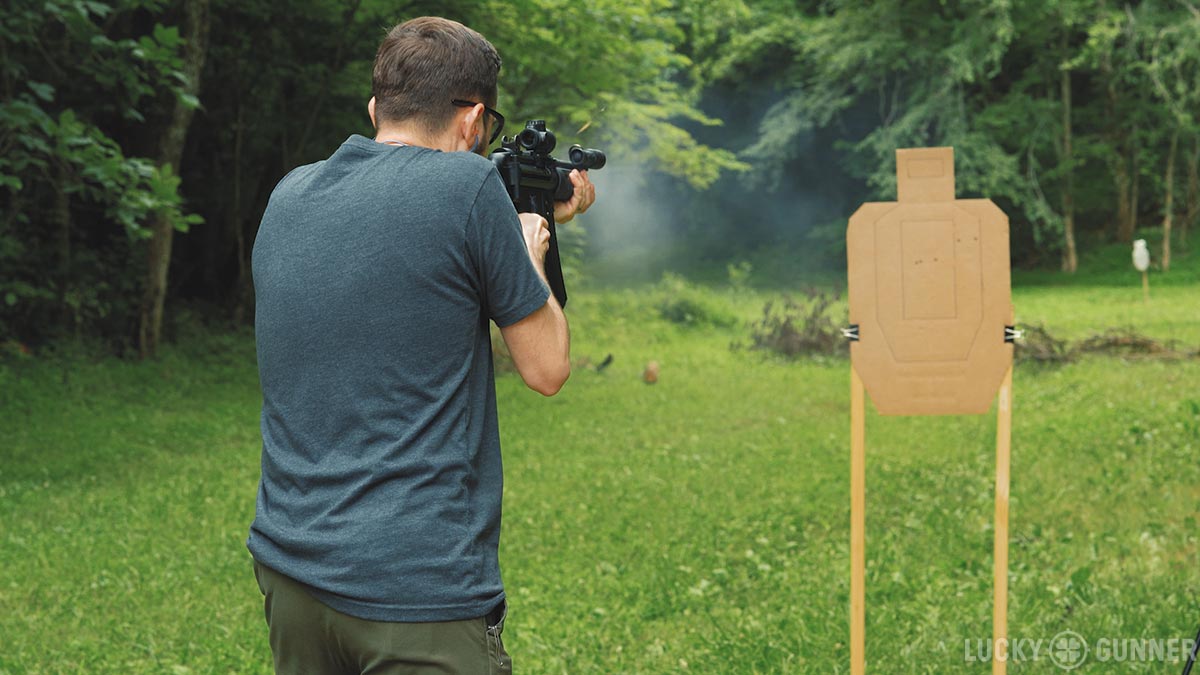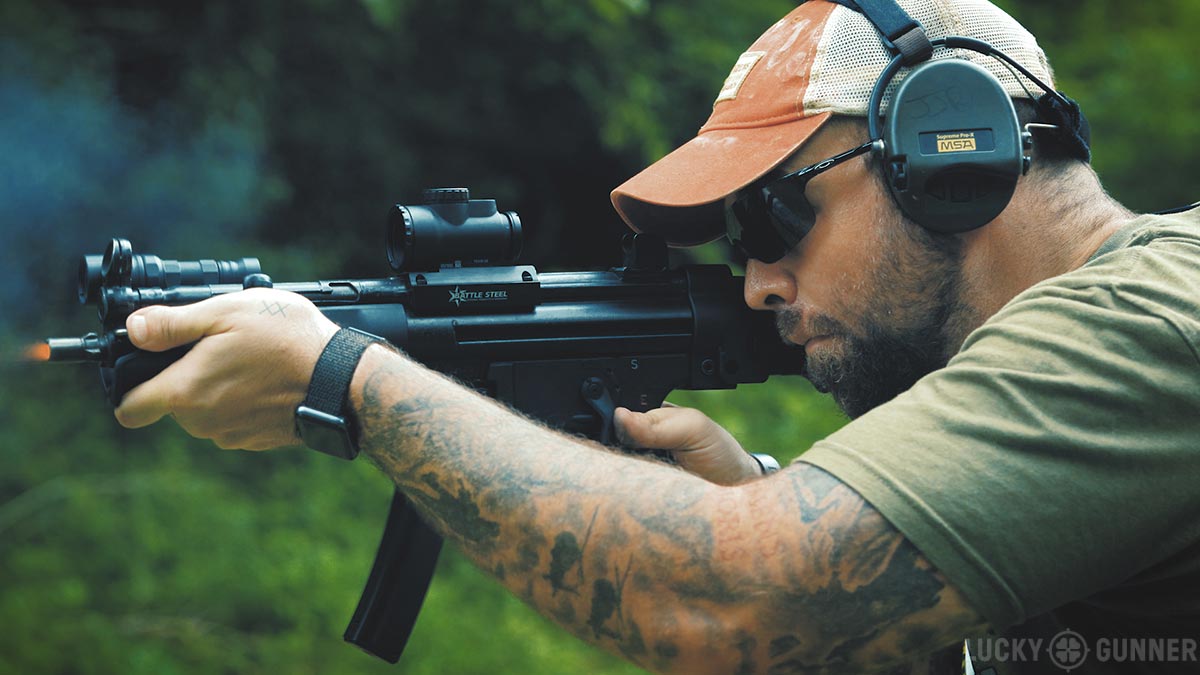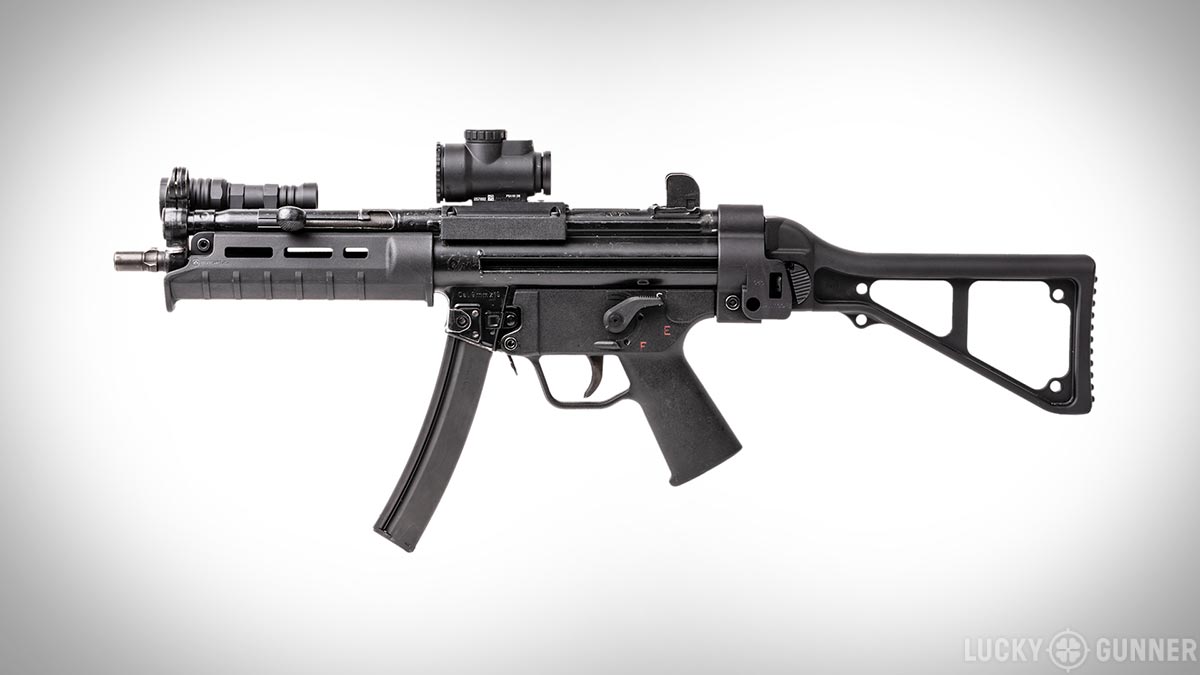It’s time for another “Stuff John and Chris Wanna Know” — this time, with a fully automatic HK MP5! Everybody knows that shooting full auto is lots of fun. But could it theoretically be controllable enough to be useful in the context of home defense? Would a controllable full auto firearm offer any benefits over other options? Is the submachine gun really obsolete? We spent some time at the range with the MP5 to find out.
CHRIS: Hey everybody, John got an MP5!
CHRIS: I am Chris Baker from LuckyGunner.com here with John Johnston from Citizens Defense Research and this is another episode of “Stuff John and Chris Wanna Know.” What is it we wanna know today, John?
JOHN: We wanna know whether or not full auto would be useful for home defense.
CHRIS: And this is totally hypothetical, right?
JOHN: Yeah.
CHRIS: Because we’re not saying you should go out and buy a full auto firearm or try to find a way to acquire one for the purpose of home defense. That’s got a whole lot of other baggage with it. Legally — not just legally owning the gun but the legal perception of using a full auto firearm. You’re kind of in uncharted territory there. The legal situation might be a little sticky for you. But, really, this was just an excuse for us to play with the MP5 and we learned a few things in the process that we thought we would share with you, our dear viewer.
So what were we looking for, John? What were we trying to figure out?
JOHN: What we really wanted to know was whether or not these guns are useful — if there’s still a place for them. They were extremely popular for 30 or 40 years and most of the time, when fully automatic fire is talked about, it’s talked about in a military context. But if we were to take an everyday, average person and, for whatever reason, they selected this as their home defense gun, at what distances would its automatic capability be useful versus a detriment?
CHRIS: Right, so you’re looking at the controlability aspect of it. At what range are you not able to keep your rounds on target? It’s an accountability issue and also, you know, stopping the target depends on you getting the hits where they need to go.
JOHN: Yeah, so, is there an advantage that is provided by this type of firearm that maybe other types of firearms don’t have?
For many years, police and government agencies, if they were going to do what people would think of as SWAT team stuff, this is probably the gun they were gonna have. When I say “many years,” we’re talking decades. There was about a 30 year period where the “high speed” guys had MP5s.
CHRIS: Right, 70s, 80s, 90s, it was shotguns and MP5s, maybe some other sub-guns in there. Now they’ve kind of gotten toward just carbines across the board for long guns.
JOHN: Right, and there are a lot of advantages to the carbine. I’m not saying this replaces the carbine — it absolutely doesn’t. I’m not saying it does a ton of things better than the carbine because it doesn’t. And I’m not talking about the difference in calibers because they’re two very different things.
But the idea that, because there are carbines around, this now no longer has a place — I don’t know about that. They’re still in use in some police agencies. I think one of the issues that a lot of people have is that they take the approach that they want to have a putter, a driving iron, and a sand wedge all in the same gun. And the carbine does that in a lot of instances, but there are certain things that this gun does that carbines just don’t.
CHRIS: Right, like shooting inside. Which would you rather have to fire?
JOHN: Yeah, and people don’t talk about that a lot. Whether the gun is suppressed or not, if I had to choose which gun I fire without hearing protection inside an occupied structure, it’s going to be a pistol caliber carbine or a sub-gun.
I’ve fired rifles with hearing protection inside of houses. It was extremely unpleasant. I’ve fired them suppressed with and without hearing protection. Didn’t like it that much. I know it doesn’t seem like that should be a deciding factor, but when we consider how important it is to be able to take in information as it comes in and make decisions based on that information, anything that disorients us — anything that affects our ability to hear or communicate — I think that is a factor. I think people don’t talk about it a lot.
CHRIS: Tell us a little bit about this gun. It’s an MP5, but there were a lot of variants and you’ve set up this one with a couple of your own modifications. Just give us a quick rundown of the gun.
JOHN: Sure, this is a 1988 vintage West German straight MP5. When I picked it up, it had a slim handguard, the fixed stock, and the original SEF lower. This one’s been upgraded a little bit with some Magpul stuff, which is incredible and has really changed how the gun handles. Specifically, the forend is Magpul and it’s got their safety selector on it. It’s got a Navy fire control module — the grip on it. Then, this is a B&T folding stock. [It also has a Trijicon MRO optic and a Modlite WML.]
I’m slowly working on it. It’s not where I want it to be yet, but compared to the gun that I got, which was left in its original configuration from 1988 to this, it’s coming right along. It’s a very compact gun that gets very small that does not compromise the performance of the caliber that its chambered in due to its size. Whereas, if you look at other popular calibers, you know, if we took like a 5.56 or a 7.62×39, and we got it to a 9-inch barrel, you’re starting to affect a couple of different things. I know someone’s going to say, “what about .300 Blackout?” Yes, .300 Blackout was designed for shorter barrels and it is more effective out of shorter barrels but it’s expensive and the subsonic ones, I’ve not seen many subsonic rounds that aren’t pretty much doing what a 147-grain HST does.
CHRIS: Yeah, pistol ballistics, basically.
JOHN: Yeah, and I have more 9mm sitting around than .300 BLK. And the other nice thing is that if I wanted to shoot this on an indoor range or something like that, it’s easy to do. There are no range restrictions [if] the backstop is not rifle rated or anything like that. So, for me, it makes sense.
CHRIS: One thing the MP5 has that’s different than a lot of the PCCs out there is that it’s not a blowback action so you don’t have a big heavy bolt and gas that’s getting in your face that basically negates any reduced recoil advantage. Shooting a lot of those blowback guns feels essentially like shooting an AR. There’s not a whole lot of difference. This is different. It’s a lot softer shooting than a rifle caliber gun.
JOHN: Yeah, it’s got a very unique recoil impulse. I think we were both talking about that when we were out on the range. Definitely softer shooting, at least perception-wise, than any of the 9mm AR-style carbines that I’ve shot. As you sort of noted there, they’re really not any better than a 5.56 and some of them are actually worse.
CHRIS: So, we’ve got carbines — rifle caliber carbines, pistol caliber carbines, shotguns, handguns. This offers a new dimension in that we are spitting out several pistol cartridges in a very short period of time. What were the splits on it when we were doing 5-round bursts?
JOHN: When we were doing five-round bursts, we had to set the timer differently so it would actually pick up the shots. And then it was averaging somewhere between .07 and .08 between every round.
CHRIS: About .35 seconds for five rounds from the first shot to the last, not including the time to get up onto target.
JOHN: Right, which is pretty quick.
CHRIS: Yeah, that’s a lot of firepower.
So, the experiment we actually tried at the range was just a basic walkback drill. We started at 5 [yards], then went to 10 and 15, and then John did 20 and 25. We fired five-round bursts in full auto and then five-round bursts semi-auto. We were looking to see how fast we could shoot those semi bursts and how well we could keep the full auto on the paper.
JOHN: Yeah, so, and a caveat here — we selected five-round bursts out of the gun because that’s kind of, I would say, not what most people would do who actually know how to use these, but it’s kind of indicative of, if I was heavy on the trigger or stressed or something like that.
CHRIS: Worst-case scenario.
JOHN: Yeah, worst-case scenario.
CHRIS: Because after, like, three rounds, you’re thinking “uhh, I need to let off.” So, you know, like you said, if you’re looking at worst-case scenario, heavy on the trigger, five rounds is, you know–
JOHN: And the other thing to keep in mind is that everything I’ve seen is that people who use these guns on full auto were training two and three round bursts whether or not they had a burst trigger pack and this one doesn’t.
CHRIS: Right, so it’s just semi or full auto on this one.
JOHN: Yeah. And, I think both of us, when we were shooting this thing were going, “Alright, we’re firing five rounds because that’s what we’ve loaded in the magazines and that’s the parameters of the test, but–.” I think you were liking three-round bursts and frankly, I would default to two-round bursts, which still happen really fast.
CHRIS: Yeah, it’s very fast. So, at five yards, let’s talk about what actually happened.
JOHN: At five yards, essentially, wherever you point this gun on full auto, there’s going to be a nice — that’s where the rounds are going. They’re not moving much at all. And in fact, the trigger on these guns is not what anyone would call “good.” But if you fire this gun in semi-auto, especially at closer distances, you are much more likely to put rounds where you don’t want them to go.
CHRIS: Right, because you’ve got five opportunities to mess up your trigger press versus just holding it down and keeping the muzzle on target.
JOHN: Yeah, I think the first rounds either of us dropped were in semi.
CHRIS: Actually, I dropped my first couple of rounds at five in full auto. Caveat being, I had fired ten rounds through this gun ever before we rolled the camera and I wasn’t really behind the gun like I should have been. But it’s not that difficult to control at five yards.
JOHN: No. I maybe had 500 rounds through it before we shot it on the range and we put another 500 rounds through it between us. It’s a very easy gun to shoot well, especially at closer distances, especially with the upgrades that I’ve done to it. Specifically, the safety selector has completely changed the way the gun handles. Again, sort of a disclaimer: yes, this is an MP5, it’s not necessarily the MP5 of yesteryear.
CHRIS: Right. So, five and ten yards, pretty much good to go. You dropped one in the [C-Zone] at 15 yards in full auto. But you also dropped one in semi-auto at 15 yards, so kind of a wash. Twenty yards is where things started getting really tricky.
I started having trouble at 15, again, [lack of] experience being a big part of that. I think with some more time on the gun — not a whole lot more — I could probably get decent hits at 15 and maybe even at 20. But even at 20, you were saying probably [smaller] bursts felt better than five rounds at a time.
JOHN: Yeah. And there are so many factors inside of that. I’m trying to think of a situation where I would have a clean enough backstop to where I would — especially in public, and at that distance, we’re talking about public — where I would feel comfortable dumping five rounds that way. I’m not saying it couldn’t happen but I would be hesitant. But I was able to keep the majority of them on the target. And I think we shot that a couple of times.
CHRIS: You did 20 yards a couple of times and you got a little better each time. You did one at 25 and that one was a little rough. So, 20-25 is kind of the “fall apart” at this point in your skill progression. But, you know, whose home has that much space? If we’re looking at this being the home defense hypothetical, 15 yards and in, probably, for the average American home.
JOHN: And at that point, 15 yards and in — I’d be incredibly comfortable and feel pretty much 100% on my round accountability in full auto inside of 15 yards. The only thing that would maybe give me pause would be if I had a crowded background or foreground as far as a family member or something like that.
CHRIS: So after we had done all of the walkback thing, we went back to five yards and we each did just a full magazine mag dump. Again, just for fun, but we also kind of learned something.
Looking at the video from that, if you look at the targets for both John and I, for the second half of the magazine, we had managed to get the gun controlled enough that all those rounds were going into just a couple of inches. A very small area. So even though the overall spread is a little bigger than that, by the time we got to the end of the magazine, we had figured out the gun enough to keep it on target.
So, theoretically, I think that means if you knew what you were doing with the gun, you could have that level of control at the beginning of a burst and be on the gun controlling it all the time.
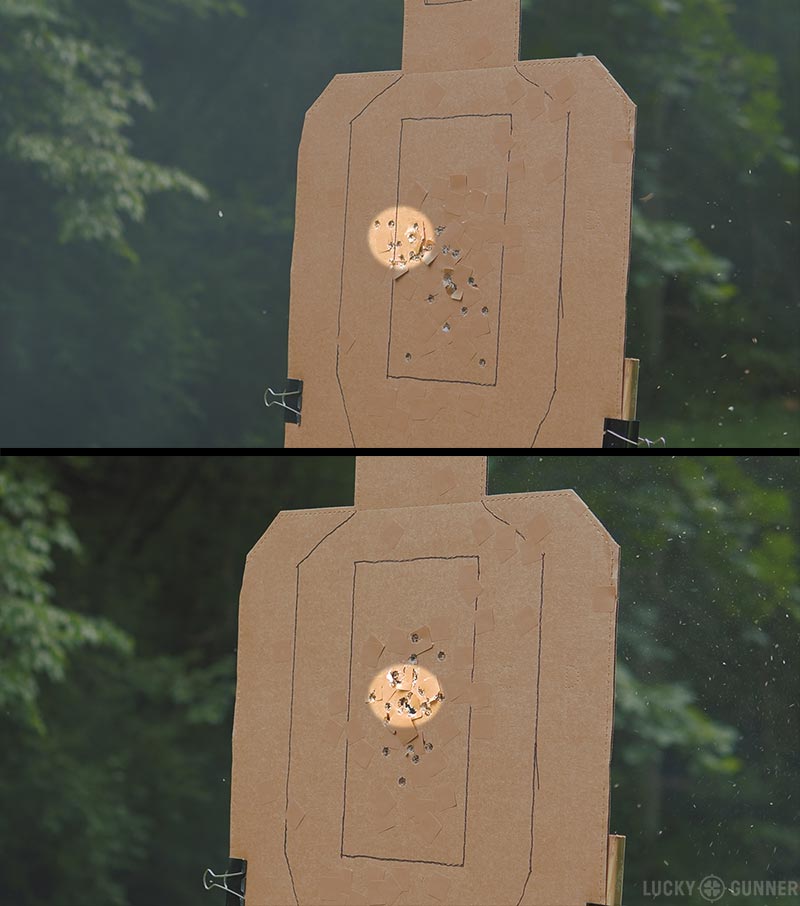
JOHN: Yeah, and I was actually really interested to see the video from that because if we’re able to do that at that point, it’s just a matter of time on the gun, shooting it full auto to figure that out. When I say “figure that out”, learn what you need to do ahead of time to just have that as performance on demand.
I think a lot of the ideas about submachine guns, how they work, how useful they are, and specifically how controllable they are, there’s just not, especially now, not a ton of people that have significant amounts of time on one, shooting it in full auto. There are some resource availability issues there. How many rounds would it take to just be able to do that on demand and I don’t know. But the fact that we were able to do it at all shows to me that it’s possible. And if it’s possible with a full magazine, it could be possible with the first two to four rounds.
CHRIS: So, is full auto useful for home defense, hypothetically? Yeah, I think it’s possible. Again, we’re talking about this particular gun. If it was a full auto AR or AK or something like that, totally different story. But this is like the best case scenario as far as full auto goes so it makes an ideal candidate for our little experiment. So yeah, all other topics aside, if it comes down to, like, you need to stop somebody real fast and they’re inside a house real close, a full auto sub-gun is not a bad tool to have.
JOHN: No, not at all. And, that’s kinda what we found out.
CHRIS: That’s what we wanna know.
JOHN: I’m John. This is Chris.
CHRIS: He’s John. Goodbye.
JOHN: … and we’re leaving.


